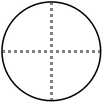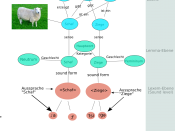Some Basic Considerations of Discourse Reference By Wu Hailan 98013 We know that the discourse analyst necessarily takes a pragmatic approach to the study of language in use. They have to take account of the context in which a piece of discourse occurs. Because the analyst is investigating the use of language in context by a speaker/writer, he is more concerned with the relationship between the speaker and the utterance, on the particular occasion of use, than with the potential relationship of one sentence to another, regardless of their use. They are always describing what speakers and hearers are doing, and not the relationship which exists between one sentence or proposition and another. In this paper, I will do some basic researches about one aspect of discourse analysis----- discourse reference, and what I mention here will prove how important it is to have a good command of it. It can help us to improve the skills of reading and writing alike.
The traditional semantic view of reference is one in which the relationship of reference is taken to hold between expressions in a text and entities in the world, and that of co-reference between expressions in different parts of a text. In the traditional approach, the term áîreferenceáï is used, together with áîsenseáï, to discuss lexical meaning. The meaning of a lexical item, such as chicken, is partially determined by its sense, that is, the component properties of áîanimateáï, áîfeatheredáï, etc., and also determined by its reference, that is , the set of objects in the world to which the expression can be correctly applied. Lyons provides a detailed account of the background and issues involved in this distinction and suggests that the term áîreferenceáï is better replaced by the term áîdenotationáï in considerations of lexical meaning. We shall follow his practice and say that, in discussions of lexical semantics, it may prove useful to claim that a lexical item has sense and denotation. This distinction is also generally covered by the terms áîintensionáï and áîextensionáï, more commonly found, in formal semantics. The term reference can then be taken out of discussions of lexical meaning and reserved for that function whereby speakers (writers) indicate, via the use of a linguistic expression, the entities they are talking ( writing) about.
It is often considered important in formal semantics that the expression used to refer to an entity must, in its description, be true of the entity. However, áîcorrectáï reference in this sense is not normally the criterion by which language-users operate when they refer to individual in discourse. In fact, it need not even be the case that the speaker believes the description to be true, but rather that he believes that, by using this expression, he will enable his hearer to pick out the intended referent. Thus, the concept which interests the discourse analyst is not that of correct (true) reference, but successful reference. Successful reference depends on the heareráïs identifying, for the purposes of understanding the current linguistic message, the speakeráïs intended referent, on the basis of the referring expression used.
This last point introduces the notion of áîidentifying the speakeráïs intended referentáï which is of crucial importance in any consideration of the interpretation of referring expressions in discourses. Despite the fact that, in some analyses, the idea is put forward that some linguistic expressions have unique and independent reference, we shall insist that, whatever the form of the referring expression, its referential function depends on the speakeráïs intention on the particular occasion of use. Next, I will say something about on what the hearer bases his identification of the speakeráïs intended referent, and what forms referring expression take.
Firstly, I talk about reference and discourse representations. An analytic distinction can be made between what is in the world and what we might describe as the representation in the mind of a person of what is in the world. This latter concept we can treat as the individualáïs representation, or model, of the world. More to the point, in paying attention to a particular piece of discourse, as a sample of experience of the world, the individual may build a specific representation of this particular experience of the world which, of course, will be integrated, to a degree, within his more general representation of the world. This specific representation, or model, arising from a particular discourse, we can characterise as the individualáïs discourse representation.
Given this extremely simple version of what a discourse representation might be, we can go on to suggest that when a writer (speaker) produces a piece of discourse, it will be based on his individual representation of a particular state of affairs. The reader ( hearer), as he receives the discourse, will normally try to build a representation ( his model ) of the state of affairs communicated by the speaker. This basic one-way version of discourse communication is quite obviously an abstraction which actually takes place between speakersáï versions of hearersáï version of speakersáï version (and so on) of representation, in normal discourse situations. However, this basic version should allow us to see that there is likely to be an inherent mismatch between what is in the speakeráïs representation and what is the heareráïs representation. At best, the hearer is likely to arrive at a representation which is only partially similar to the speakeráïs and which, moreover, can only ever be a partial reflection of the so-called áîactualáï state of affairs which existed in the world. A strong version of this view would be that áîhuman understand what is said to them in terms of their own knowledge and beliefs about the world.
When a speaker, on the basis of his representation, uses an expression to pick out an individual entity, he will typically take into consideration those features of his heareráïs developing discourse representation which he can depend on the hearer being able to use in identifying the intended referent. The assumption of a similar general expression of the world, sociocultural conventions, awareness of context and communicative conventions are some of the relevant features. The hearer, for his part, will also generally assume that the speaker is operating with those assumptions and will base his identification of the intended referent on an interpretation of the linguistic expression which is consistent with those features which are the basis of the world created by his developing discourse representation.
Generally, then, the hearer will build a representation of the discourse which will contain representation of entities introduced by the speaker through the use of referring expressions. Clearly, in order for the hearer to do this, he must operate with some regular notion of what types of expressions, under what conditions, are used to refer to entities.
Secondly, I talk about referring expression. There is a vast literature in philosophy and linguistics on the nature and status of expressions which can, or cannot, be used to refer. Since much of the debate revolves around issues of truth, existence and uniqueness, and concerns itself with single system sentences, cited in isolation from any communicative context, the controversies may appear rather esoteric to the practical discourse analyst. After all, the discourse analyst is largely concerned, in his investigation, with data which is the product of the actual use of linguistic expression in a definable context for a particular purpose, rather that the potential use of such expression.
There are some indefinite expressions such as a man, a rainbow, a beautiful girl, a line, which are typically used to introduce entities into the discourse. In each of these examples, we can say that the speaker intends the hearer to recognise that there is an individual entity referred to by the expression used. It does not seem to be a necessary condition of this type of introductory reference that the hearer should be able to áîidentify uniquelyáï, in any strict sense, the individual referred to. There are, of course, recognisable circumstances in which an indefinite expression is unlikely to be taken as a referring expression.
The other generally recognised condition in which indefinite noun phrases may not be treated as referential is when they appear in linguistic contexts which are áîreferentially opaqueáï. Referential opacity can occur after certain verbs, such as look for and want. The classic examples take the following form: 1) Marion is looking for a rubber.
2) Virginia wants a new job.
It may be that, in uttering these sentences on a particular occasion, a speaker does have a áîspecificáï referent in mind. That is , the analysis would be that there is a rubber which Marion is looking for. However, the indefinite expression, a rubber, could be used to mean áîany rubberáï, and in this áînon-specificáï reading, it is not being used referentially. It may be that the so-called áîambiguityáï of sentences like 1) and 2) arises because they are cited without contexts. We would suggest that, in the analysis of naturally occurring discourse, the analyst will have clear contextual or co-textual cues to guide his assignment of referential or non-referential use to these indefinite expressions. He may also be able to appeal to phonological or more general paralinguistic clues in deciding when other indefinite expressions, such as someone, something, are being used to refer to a particular individual or not. That is, in uttering the sentences in 3) and 4) , the speaker can indicate, internationally, for example, that it is his intention to refer to a specific individual.
3) Someone ( and I know who ) wonáït like this proposal.
4) Someone ( and I donáït know who ) has stolen my bicycle.
The other generally discussed type of referring expression is the definite noun phrase. The paradigm uses of definite noun phrases are in subsequent reference to an entity or to salient objects in the physical context. One widely discussed point made by Donnellan is that some definite noun phrases, even as subjects of their sentences, may be used áînon-referentiallyáï. Donnellanáïs argument is aimed at the prerequisite, in some philosophical approaches to the analysis of definite descriptions, that the expression used must pick our a single individual in the world in order for the reference to be correct. The other is that hearers pick out speakersáï intended referents, on a fairly loose interpretation of what áîattributesáï are included in the definite descriptions. An important point is that our interpretation of expressions such as the chicken and the newspaper, when used referentially, is based on our pragmatic knowledge of the range of reference of such expressions, which is, on a particular occasion of use, strictly constrained and áîdetermined by the nature of the predication, and by the conversational contextáï. We could say that these factors in influence the heareráïs (readeráïs ) representation of discourse entities, not only for definite descriptions and proper names, but, more crucially, when pronominals are encountered in discourse.
What I mention above is my basic considerations of discourse reference. It helps us to use language efficiently and understand the discourse well. More attention need to be paid on it when we do the discourse analysis.





